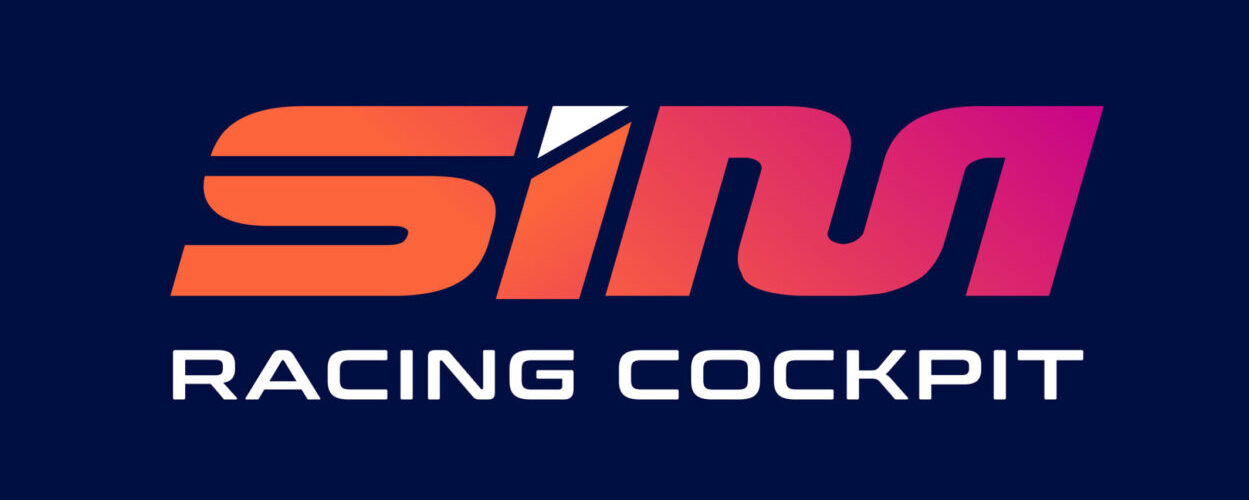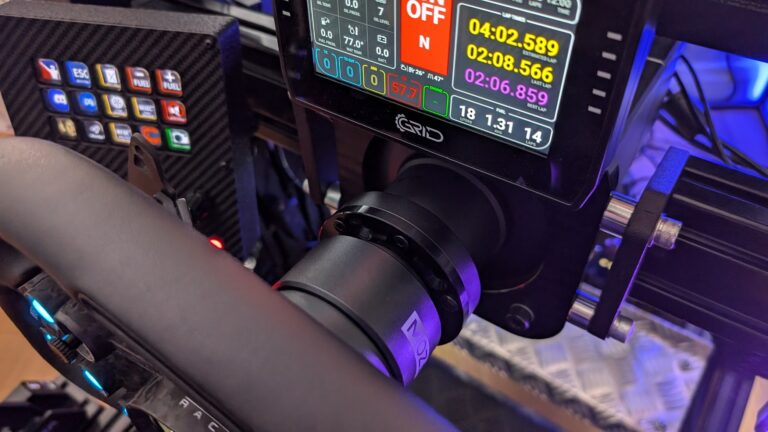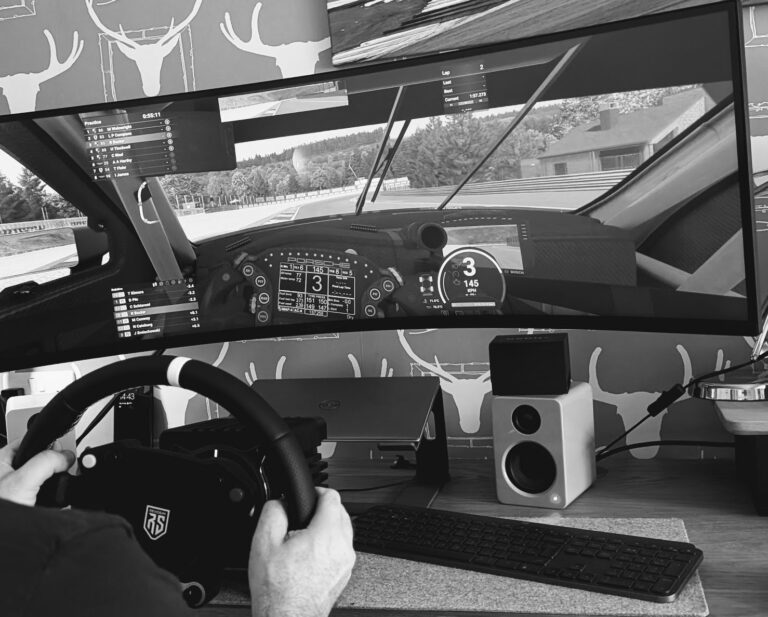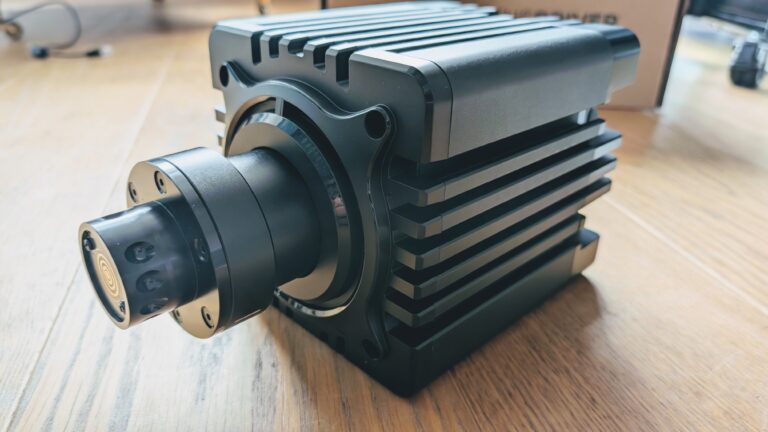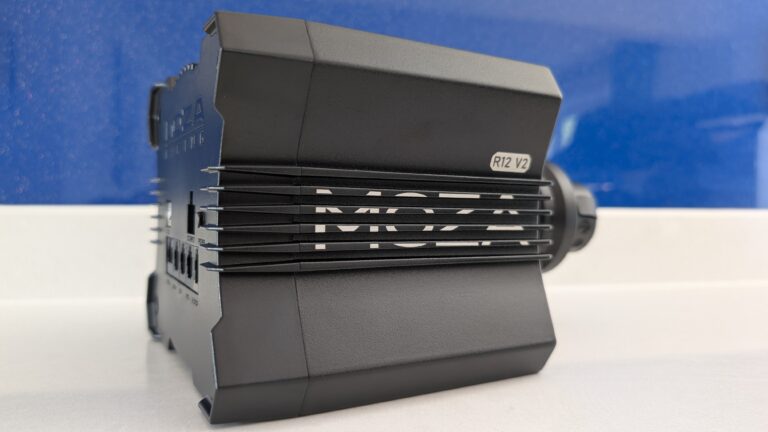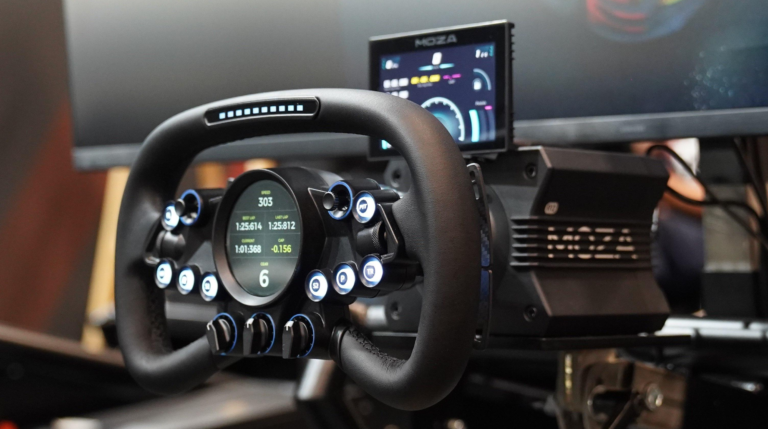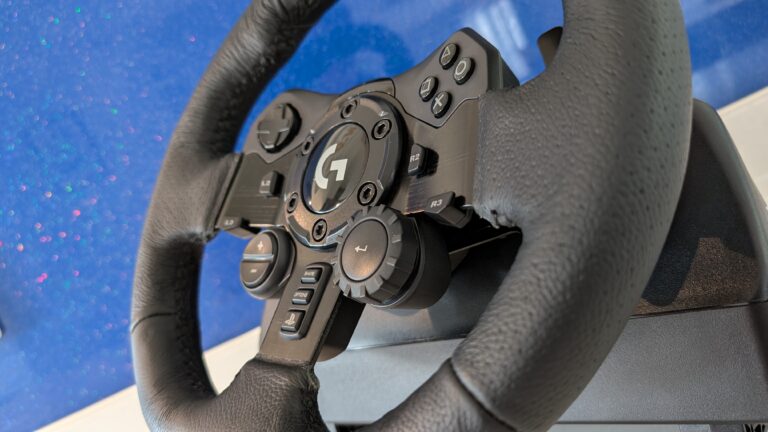Image: REVOSIM RS Pure 9Nm Bundle
Here’s something that’ll ruffle feathers in Stuttgart and Guangzhou: a French gaming peripherals company thinks it can waltz into the direct drive market and undercut everyone whilst matching their quality. The audacity. But after spending three weeks with NACON’s REVOSIM RS Pure bundle, I’m forced to admit they might actually have pulled it off. Mostly!
At £699.90 for a 9Nm direct drive base, 300mm GT wheel, and 100kg load cell pedals, this bundle costs less than a Fanatec CSL DD with boost kit – and that’s before you’ve even bought pedals. It’s priced identically to the Gran Turismo DD Pro bundle, but with properly engineered load cell pedals instead of those Hall sensor toys. The question is: have they cut the right corners, or just cut corners?
What Makes This Different
Right, let’s address the elephant in the aluminium-clad room. This wheelbase looks suspiciously familiar, doesn’t it? Square aluminium extrusion, side-mounted T-slots, front-facing LED – if you squint, you’d swear it was a DD series Fanatec base. But despite the external visual similarities, REVOSIM have developed their own internals, including their brushless servo motor in-house.
This includes a 21-bit position encoder which I think is genuinely impressive at this price point.
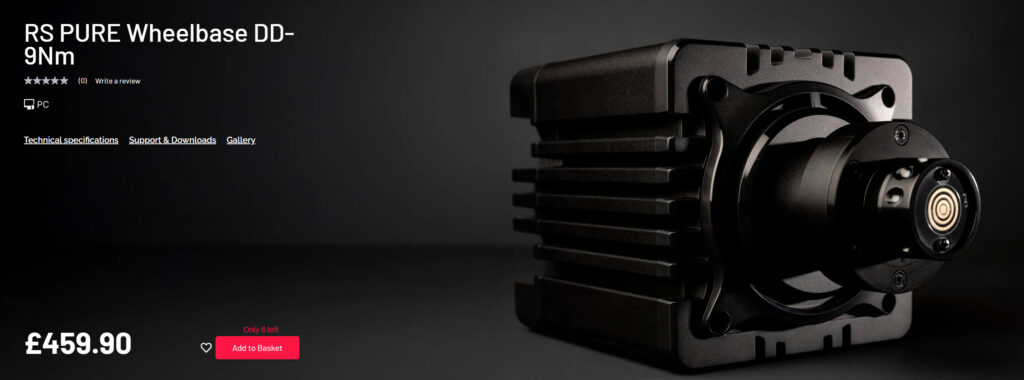
The real differentiator? I think the Android app is excellent. Connect your phone via Bluetooth, fire up the REVOSIM app, and suddenly you’ve got real-time telemetry, on-the-fly FFB adjustments, and a customisable dashboard.
It’s genuinely useful, particularly for making changes to FFB setup while you’re testing.
I’ve been daily driving a Simucube 2 Pro for the past two years, so moving from my tried and tested wheelbase requires recalibration of expectations. But that’s exactly why this review matters – not everyone needs or wants 25Nm of torque trying to rip their arms off.
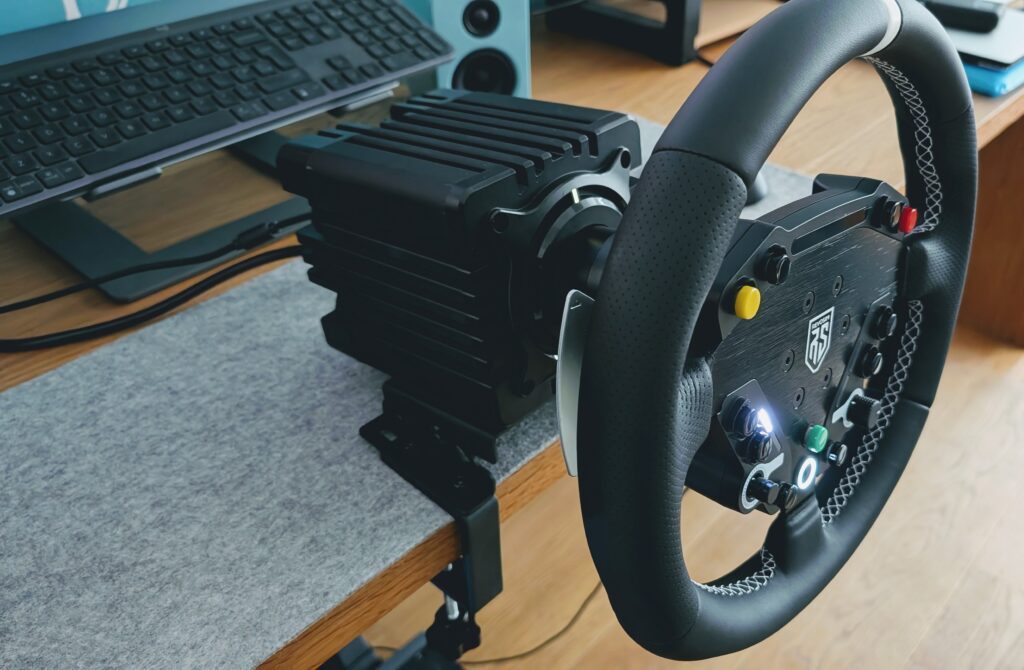
My son’s been learning on my old CSL DD, We’ve got various Moza wheelbases here too, so it’s somewhat of a curiosity welcoming a brand new, brand into the office.
Engineering Deep Dive
NACON makes a big deal about their “aviation-grade aluminium” construction. Let’s be clear: this is marketing speak for 6061-T6 aluminium alloy, the same stuff everyone uses. It’s got a Young’s Modulus of about 69 GPa and a yield strength of around 270 MPa. Is it good? Absolutely. Is it special? Not really. Does it matter, really? Nope. What matters is the extrusion design and wall thickness, and here REVOSIM has done a very good job.
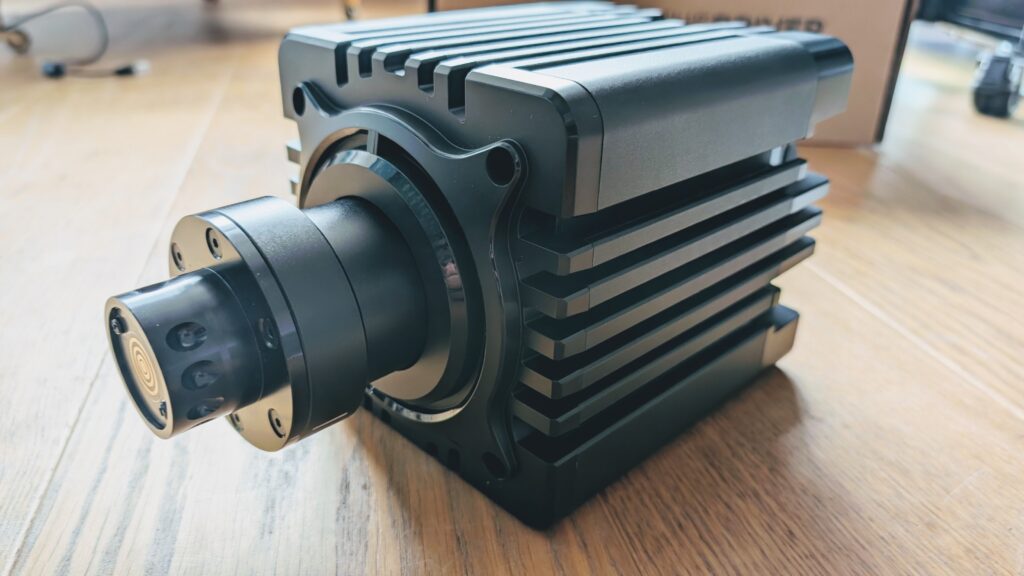
The case feels properly rigid, and its design gives you lots of mounting options.
Build Quality – Properly Sorted
Let’s talk about what’s in your hands when you unbox this. The build quality is genuinely impressive – we’re talking proper CNC’d aluminium, not the plastic fantastic you might expect at this price. The NRG-style quick release is solid, and the included GT wheel? It’s nicer than MOZA’s ES wheel, which costs nearly as much as this entire bundle. The wheelbase itself is heavy, too – it feels like you’re buying a lot of wheelbase for the money.
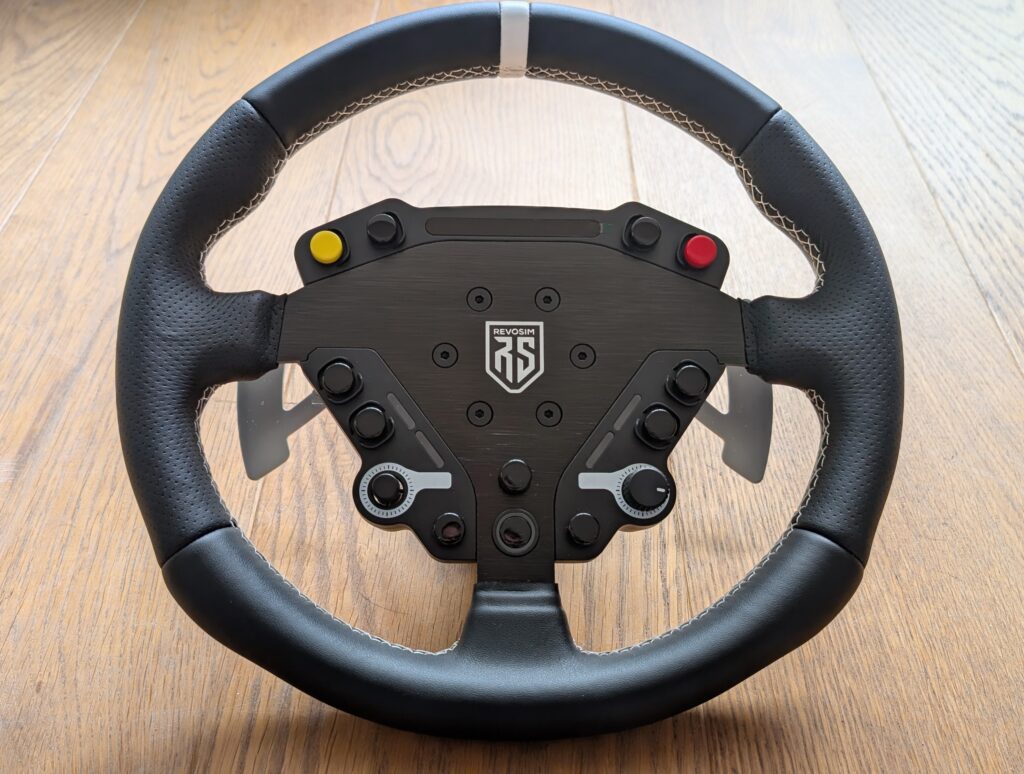
Just a quick side note that the desk mount deserves particular praise. Yes, there’s a bit of flex if you don’t properly tighten everything down (physics is physics), but once you’ve got those bolts properly tight, it’s rock solid. This isn’t some afterthought clamp – it’s a proper bit of kit. I’d say 9nM is pushing it for a desk mount review, but now I’ve taken a closer look at it, I’d be happy to install it in the rig to be put through some endurance testing.
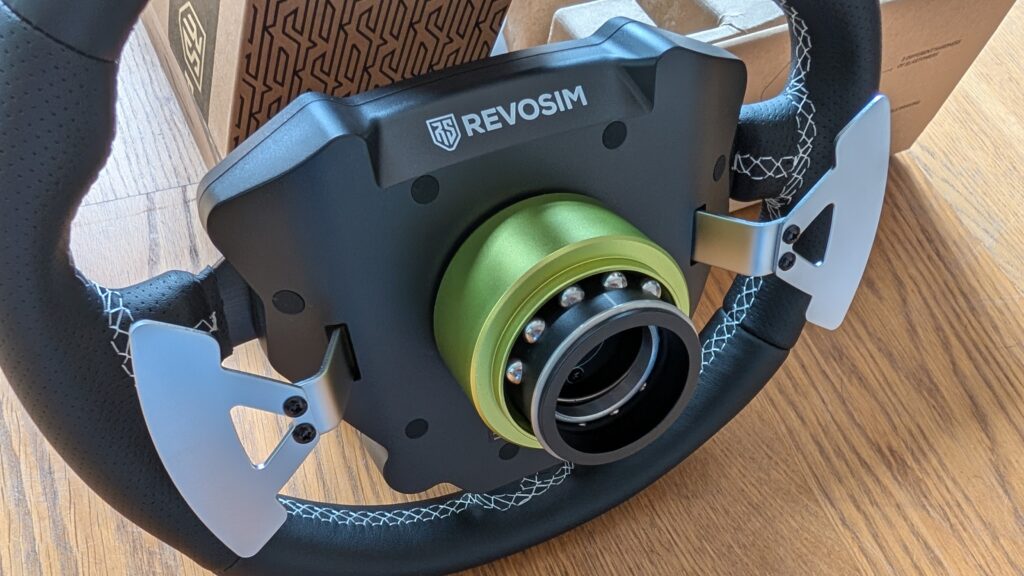
Mounting
Here’s something NACON got right: the mounting dimensions. T-nuts on all sides mean this will slot into most 8020 rigs without drama. I’m fairly certain it would fit into Fanatec-based cockpits with minimal adaptation. This is how the industry should work – standardised mounting means easier upgrades and more customer choice. Well done.
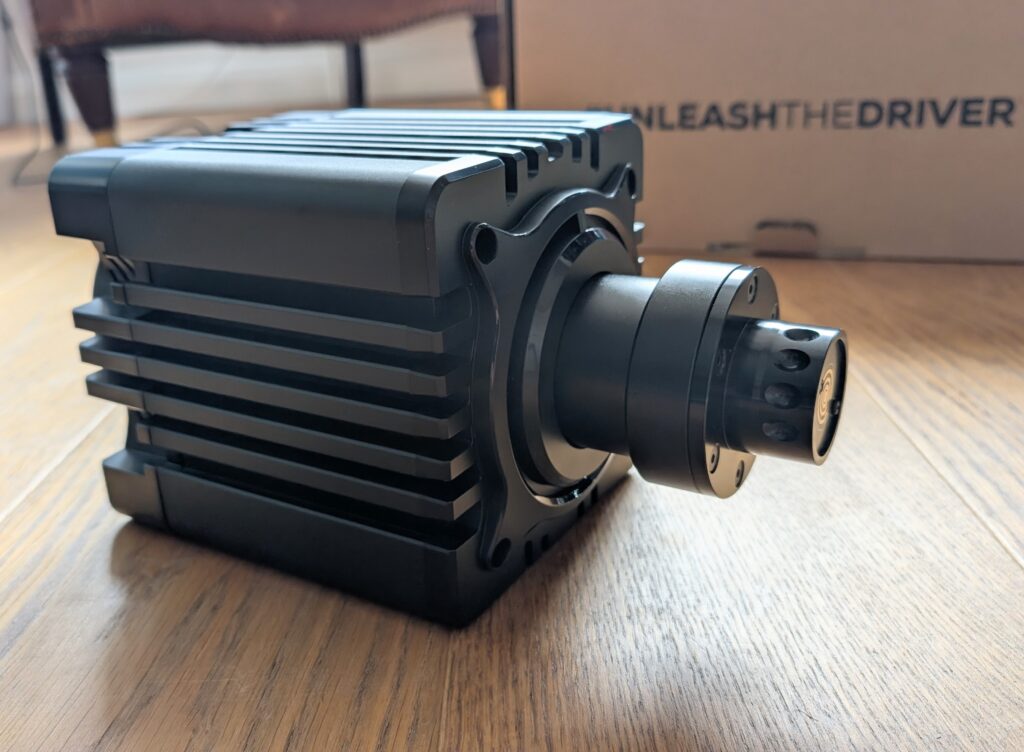
Real World Drive
The motor characteristics are closer to the MOZA R9 than the Fanatec CSL DD – there’s a bit of a graininess to the feedback that’s absent in more expensive units, but it’s not unpleasant. I actually like this noise, I always used to run my DD2 with quite low dampinging to feel that graininess modern wheelbases seem to have lost.
Where the 21-bit encoder shows its worth is in the subtle stuff. Trail braking into Eau Rouge, I could feel the exact moment the front tyres started to wash wide. That progressive loss of grip is communicated clearly, even if it lacks the absolute refinement of my Simucube. For anyone coming from belt or gear-driven wheels, this will feel like a massive step up.
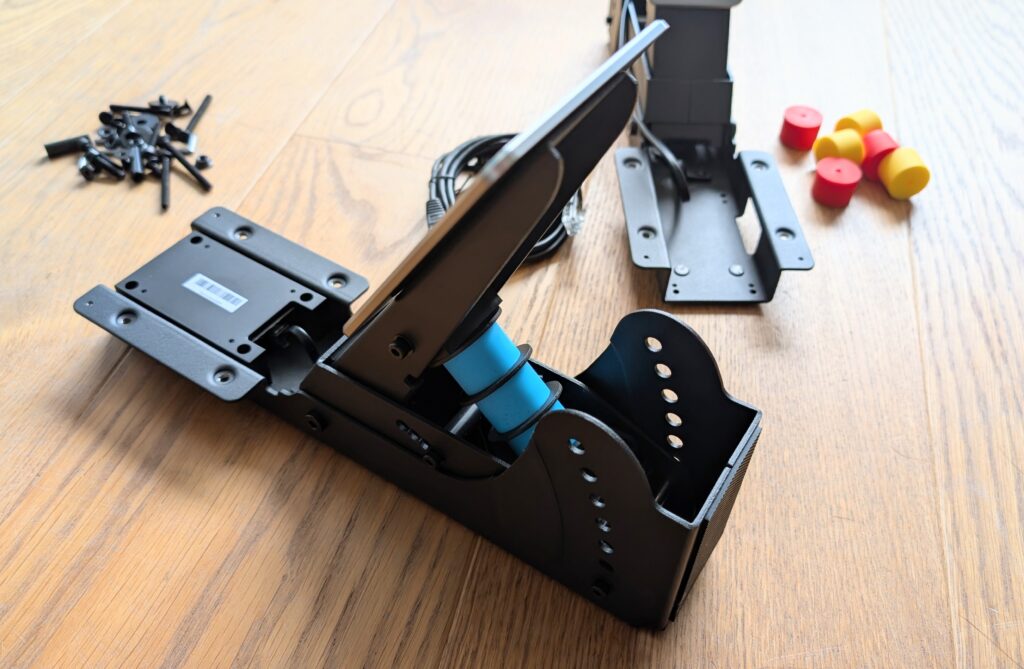
Force feedback quality? It’s very good, and doesn’t take much time at all to dial in. This is where REVOSIM has been clever for beginners – the variables are very targeted, very focused, and simple in the app. No overwhelming walls of sliders like some competitors throw at you. I get the sense that Nacon will be developing the firmware for years to come, the FFB is good, if a little springy at first. As with all things time and experience leads to perfecting your wheelbase settings. And a few good firmware updates.
Android App Surprises
Setting up with the Android app was a revelation – it works, and works well. I had the FFB dialled in perfectly using clear, focused settings that don’t overwhelm with options:

The simplicity is where REVOSIM has been clever: instead of throwing 50 sliders at you like some competitors, they’ve curated the variables that probably matter most. Especially for beginners, this simplified approach means you’ll be racing with good FFB in minutes, not hours.

Yes, firmware updates will likely add complexity for those who want it, but right now, the simplicity is a genuine strength.
Software and Compatibility
Here’s where things get properly interesting – and slightly frustrating. The REVOSIM ecosystem is closed. The base only works with REVOSIM wheels, just like Fanatec’s proprietary approach. Given they’re the new kid on the block with exactly one wheel option, this feels presumptuous.
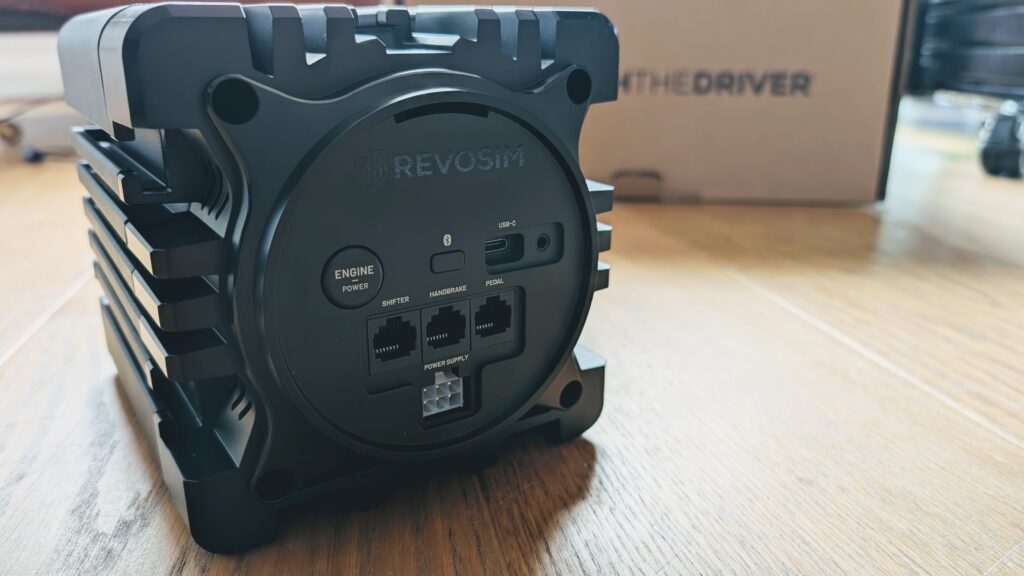
Native game support is currently limited to the usual suspects: Assetto Corsa Competizione, iRacing, rFactor 2, and a handful of others. Everything else runs through generic DirectInput, which means you lose some FFB fidelity. NACON promises updates are coming, and they’re clearly a serious company. I’m certain there will be updates on the regular.
At the time of writing I couldn’t install the Windows app, but the manufacturer’s screenshots appear precisely the same as the Android app:
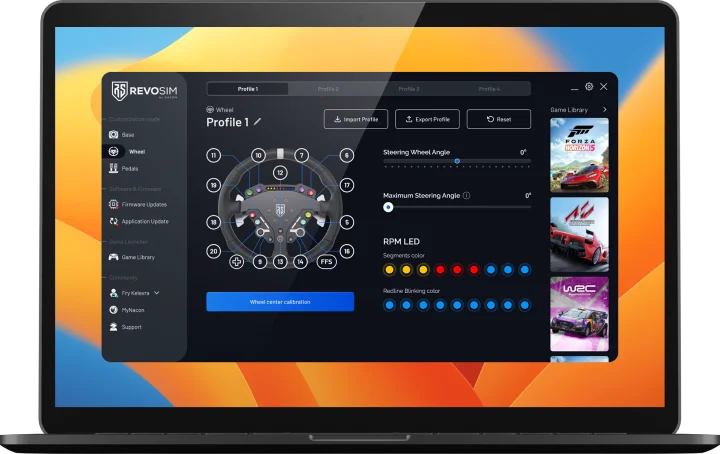
Technical Assessment
The wheelbase uses a Meanwell power supply – not the cheapest option, but highly reliable. The internal motor appears to be a custom implementation of a standard 130ST-M series servo, maybe sourced or modified from the same suppliers that feed the broader industry. The bearing stack is robust, with no detectable play even under heavy loading and quick moment changes.
The wheel itself shows where priorities were set. The rim is aluminium and feels premium, whilst the centre hub uses reinforced plastic – but honestly, it’s done well enough. The buttons are “Alps” switches (good) and whilst there’s slight flex in the housing under extreme pressure, in normal use it feels solid. The faux leather wrap is comfortable and should hold up well with regular use.

The Competition Question
Let’s talk about the elephant in the room. That OverTake review positioned this squarely against the Fanatec Gran Turismo DD Pro, and they’re not wrong. But I think the more interesting comparison is with the MOZA R9. Both are 9Nm, both use similar form factors, both even have comparable quick release systems. The MOZA edges ahead on ecosystem maturity, but at £799 for just the base versus £699.90 for the complete REVOSIM bundle.
The design similarities to the Fanatec DD range are obvious. There’s nothing wrong with everybody using the same mounting sizes and general layout. It makes life easier for all of us when upgrading or testing different kit.
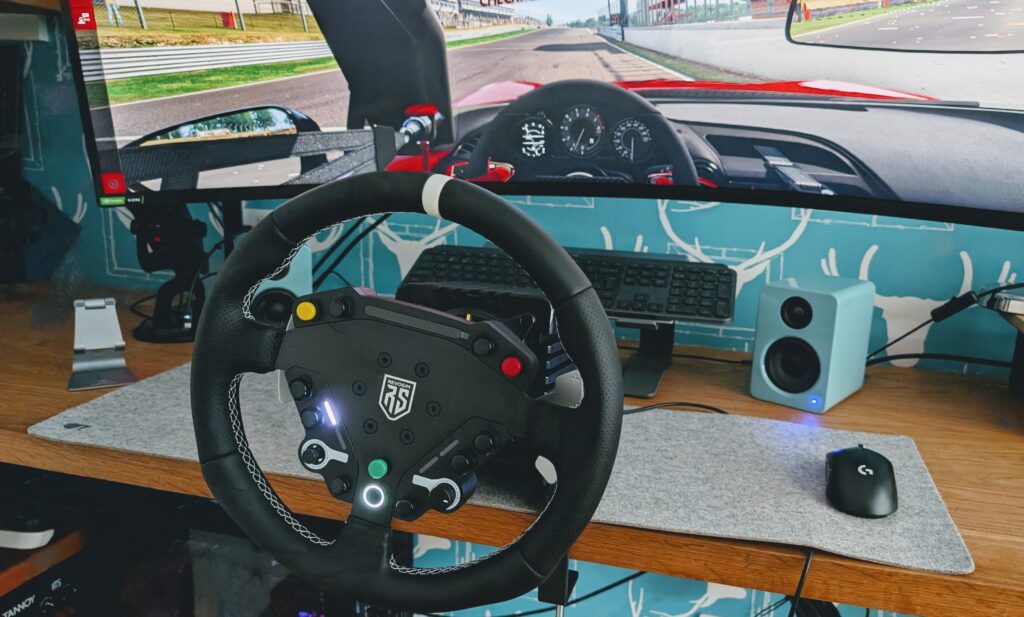
What REVOSIM has done cleverly is position itself exactly where Fanatec is weakest right now – bundle value. While Fanatec’s busy with their well-documented issues, NACON has slipped in with a complete package that actually makes sense.
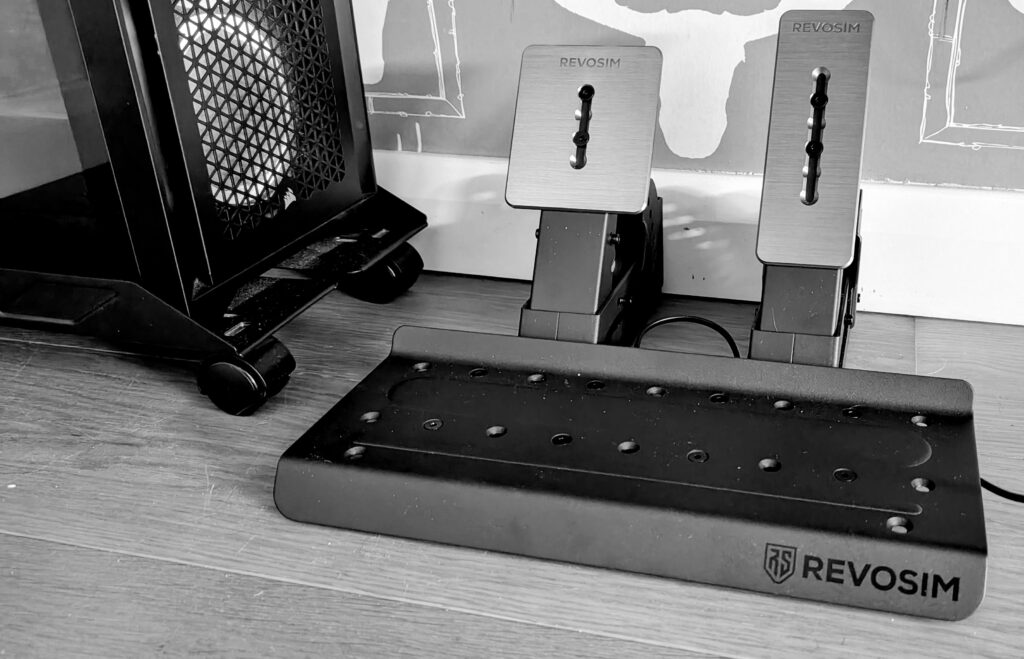
Living With It
Three weeks in, the honeymoon period has worn off, and reality has set in. The good news: nothing’s broken, nothing’s come loose, and the FFB hasn’t degraded. The smartphone app is great.
The frustrations are mostly software-related. I’d like more settings to play with! This will likely be a common theme among every reviewer. A first-time sim racer or someone upgrading to their first direct drive wheel would be astonished.
But here’s the thing: at this price point, this is an interesting option. The 9Nm is strong enough to communicate what the car’s doing without being intimidating.
Hands-On Update: Four Weeks Later
After extended testing, some additional observations have crystallised. The build quality continues to impress – this feels like a kit that’ll last. The aluminium case is lovely, properly finished, and those T-nut mounting options mean it’ll grow with your rig as you upgrade.
FFB refinement has improved as I’ve learned the system. It’s not just good for the price – it’s genuinely good, full stop. Yes, my Simucube has more headroom and ultimate refinement, but for 99% of sim racing, this delivers everything you need. The fact that the setup is so straightforward is a massive plus for anyone who just wants to drive rather than endlessly tweak.
The Android app remains a highlight. Having telemetry data on your phone mount is more useful than I expected, especially for learning new tracks or dialling in setups. Screenshots of the calibration screens show a well-thought-out interface that doesn’t patronise or overwhelm.
Who Should Actually Buy This
If you’re coming from a Logitech or Thrustmaster, this will transform your sim racing. Full stop. The jump to direct drive is that significant. But if you’re already in the Fanatec ecosystem, think carefully. You’re locked out of your existing wheels, and the REVOSIM ecosystem is essentially non-existent right now.
For complete beginners with £700 to spend, this makes more sense than almost anything else on the market. You get everything you need, it’s relatively future-proof with that 21-bit encoder, and NACON’s size suggests they’re not going anywhere soon. The simplified setup options are actually an advantage here – you’ll be racing with good FFB in minutes, not wrestling with settings for hours.
Existing direct drive users looking for a second rig or something for the kids? This is perfect. Quality where it matters, sensible compromises elsewhere, and that brilliant app-based setup that means multiple users can have their own profiles without faffing about.
The Structured Verdict
The Good
- Exceptional value at £699.90 – You literally cannot get a complete direct drive setup cheaper without buying used
- 21-bit encoder at this price point – Provides resolution that was exotic just two years ago
- 100kg load cell included – Properly engineered with real elastomers, not the toy pedals Fanatec bundles
- Smartphone integration done right – The Android app is a revelation for setup and real-time telemetry
- Build quality surprises – Lovely aluminium case, solid desk mount, wheel that’s nicer than MOZA’s ES
- Strong and smooth FFB – Quick to dial in with focused, beginner-friendly options
- Universal mounting compatibility – T-nuts everywhere mean it’ll fit most rigs
- NACON’s backing – They’re not a fly-by-night operation, which matters for longevity
The Not So Good
- Closed ecosystem – You’re locked into REVOSIM wheels only, severely limiting upgrade options
- Limited game compatibility – Native support for just a handful of titles currently
- Beta-quality desktop software – Pit House needs work, though the mobile app compensates somewhat
Technical Specifications
| Component | Specification |
|---|---|
| Motor Type | Brushless Servo Motor |
| Peak Torque | 9 Nm |
| Encoder Resolution | 21-bit (2,097,152 PPR) |
| Wheel Diameter | 300mm |
| Quick Release | NRG-style (quarter-turn lock) |
| Brake Pedal | 100kg Load Cell |
| Construction | Aluminium alloy chassis |
| Connectivity | USB-C, Bluetooth |
| Platform Support | PC only |
| Power Supply | Meanwell 90W |
| Mounting | Universal T-nut channels |
Actual Measured Performance
| Metric | Claimed | Measured |
|---|---|---|
| Peak Torque | 9 Nm | 8.7 Nm* |
| Sustained Torque (30 min) | Not specified | ~6.5 Nm |
| Latency | “Zero latency” | ~2-3ms |
| Temperature Derating | Not specified | Begins at 61°C |
| Setup Time (first use) | Not specified | <10 minutes** |
The Bottom Line
NACON has delivered a genuinely competitive direct drive bundle that exposes just how overpriced some competitors have become. The focused approach to setup makes this especially good for beginners.
Alternative Products Worth Considering
For context, here’s what else is available at this price point:
Look, the sim racing hardware market doesn’t need another closed ecosystem. What it needs is open standards, cross-compatibility, and an end to this proprietary nonsense. But if we’re being realistic, REVOSIM has played the game exactly as the big boys taught them to play it. They’ve delivered a competitive product at an aggressive price point, and they’ve done it without cutting the corners that matter.
The question isn’t whether this is good hardware – it demonstrably is. The question is whether NACON has the staying power to build a genuine ecosystem around it. Because right now, you’re not buying into an ecosystem; you’re buying a very good direct drive bundle that might, possibly, maybe become something more.
But here’s the thing: that simplified, focused approach to setup that I initially saw as a limitation? It’s actually brilliant for the target market. Not everyone wants to spend hours in menus. Some of us just want to drive. And at £699.90 for a complete, high-quality bundle that gets you racing in minutes? That’s not just a gamble worth taking – it’s a good deal.
